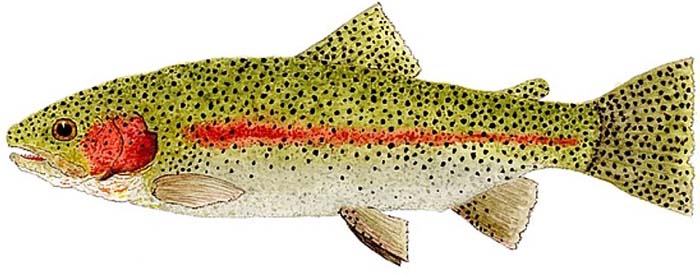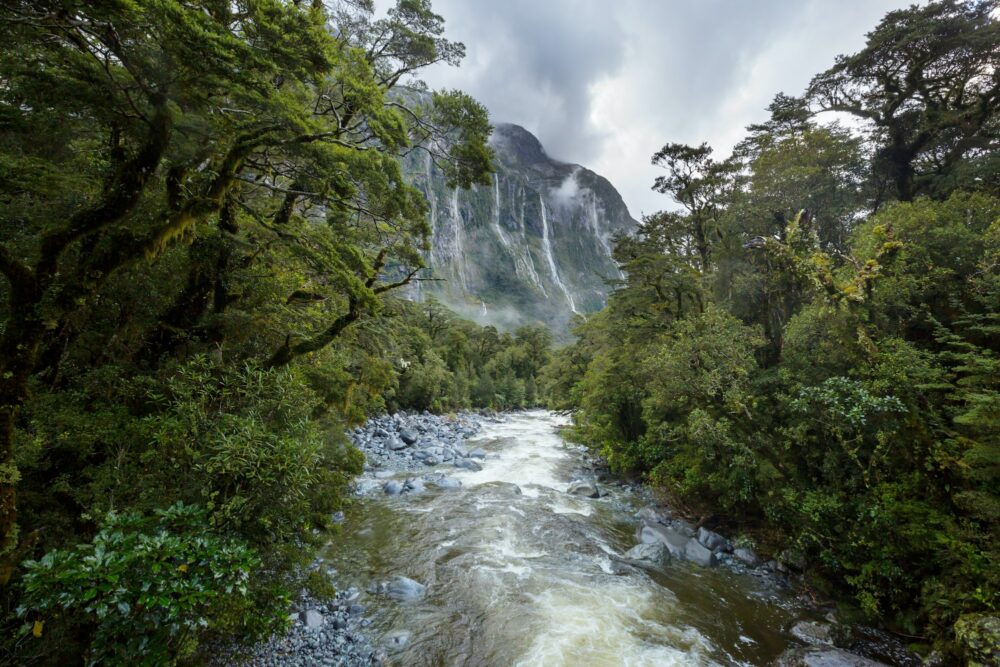
Photo Gore, New Zealand, by Oren Rozen – a commons image. I stayed here for about a week and fished a river that ran through a sheep station, so the water was private. I caught more trout that week than seemed humanly possible – some periods hooking a fish on every cast. According to my guide, the largest was a 5-kilo brown [11-pound], but there were many in that league in New Zealand.
In 1991 New Zealand, boys and girls biking from school with fly rods was as common a sight as our yellow school buses clogging the roads
By Skip Clement
I’d been warned about noise, what trout can hear, and how to traverse the benthic compositions of New Zealand waters by Paddy Clarke, my first guide in NZ. He managed a 35,000 acres sheep station on North Island near Taupo.
During our hour-long drive and two-hour walkabout on the sheep station, we’d passed up or forded several inviting streams in his vintage Land Rover that had no springs – my arse and spinal cord serving that purpose. Our destination was a river [forgot name] that was the border dividing the sheep station and thousands of acres of indigenous Maori lands. We would fish a single tributary of the hundreds that fed the shared border river.
It was January, like northern hemisphere June, but down under [yes, the toilet flushes/drains the other way], and I was sure I knew more than most about freshwater fly fishing for trouts. But then, things happened: I got exposed to reality, and my prior experiences in my home state of Pennsylvania and destinations like Montana and Argentina seemed parochial. So it turned out I hardly knew anything, and some of my mentors, read or known, didn’t know that much either.
- My trip down under to New Zealand lasted an entire fishing season of more than five months.
- New Zealanders, BTW, are the most hospitable people I have ever known.
- And saying, ‘I just had three beers.’ – Means you’re drunk – alcohol-rich beer.

Salmo trutta illustration by award-winning watercolorist Thom Glace. Used with permission.
The guides
I met Frank Murphy, Paddy Clarke, the inimitable Hughie McDowell, and numerous other fly fishing guides on my six-month sabbatical. Many were European tournament fly fishers and Commonwealth tournament anglers. All great anglers and fly tyers.
Hughie McDowell tied innumerable number #18s and smaller dries for me using only his two hands with thick blacksmith fingers. Tools: a hook, some deer hair, and thread while standing in the water facing a stiff breeze – never saw anything like it before or since. He was also the fly fishing champion of Ireland.
Passing the time we squared off occasionally for a target game – 30/35-feet away. Hughie could hit the target, repeatedly, after one false cast. I never beat him.
In my opinion, the New Zealander guides in the ’90s were better than most US freshwater counterparts- except the American West and Florida Keys guides. However, I don’t believe the disparity of guide scholarship exists today.

Almost every fly in this book is bankable in the US and all in New Zealand. More modern materials can be used, but that’s not necessary.
What Fish Hear
Water has a density greater than air, around a thousand times denser than air. Sound in the finned environment travels about a mile a second, or roughly five times faster than in the air. So, the importance of sound to a trout’s survival has, over the millennia, led to unique ways to detect ‘sound.’
Hearing – you can’t be serious; cleats?
- Inner ear—Although humans don’t have an external ear, their body tissue is the same density as water, so sound passes unmuted to the inner ear.
- Near fields up to about 25 feet [+/-], fish can use particles to bounce back and forth and hear in the inner ear. The inner ear also detects the far field, and the swim bladder amplifies it.
- Lateral line—Some fish can detect and catch prey within 10 to 20 feet by using their lateral-line system. This is especially useful for detecting nearby moving prey or predators and avoiding running into objects at night or in the darkness of turbid or deep water.
What an angler needs to know about trout
‘Putting cleats on wade boots is ridiculous; it’s like arguing over what kind of cup improves drinking hemlock.’ — McDowell

Rainbow – watercolor illustration by Thom Glace.
- Fish will bolt if a sound is unnatural, but fish will get used to road traffic and other human-made noises if repeated. However, clomping along with cleats in your wading boots is plain ridiculous. Slam a fly on the water and forget about a redo – they’re all gone. However, plop a damselfly on the water, and you’re good.
- The idiot brother-in-law dropping stuff and clanging around on the skiff deck will chase fish for a long way off.
- All of the above should alert you that your cast, fly selection, and all critical retrieve must be planned out. Oh, and the greenish-blue fly line and leader material are less visible. Don’t kid yourself about Fluoro.






